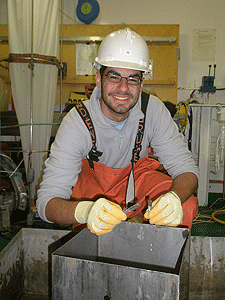A hectic day on the field.
31.07.2008 ”I‘m not moderate anymore!” I’m absolutely sure every time I open my mouth, and uncertain when I close it”, that can be a suitable saying. It’s not given to everyone to pick up all information and get up early not to miss any action. As one of the diary writers, who got up at 05.00 a.m. not to miss any of the exciting core-tests which were supposed to take place. Well, the boat decided to slow down during the night…

Main content
A couple of hours delayed, the researchers are ready to take their tests. G.O.Sars arrives at the area, and a CTD is taken. All necessary instruments are adjusted to the results, and the next operations are a "boxcore"-, "multicore"- and a "gravitycore" test.
All the different researchers throw their selves over the sediments and water from the core tests, taken from about 700 meters dept, to do their different kind of analyzes. Researcher of geochemistry, Yifeng Chen is taking water from the pores of the sediments. This water she will bring with her to Trondheim and the Institute of Geological research, where it will be examined for methane gas and carbon cycle (if it exist and how it happen).
After all the core-tests are taken, the ROV is ready to dive. For several hours, technicians and chief of instruments have worked hard to get it ready, and finally it's on its way down to over 700 meters deep. On the monitor, we are able to watch live pictures sent by the ROV. It looks like snow; thousand of particles in different sizes float around in the sea. All the posts on the sentry have been abandoned. Eager to finally have the opportunity to take some tests from the "gravitycore", the geologists rush down to the labs on deck 2. Therefore, a slightly daze teacher got the responsibility to log the exact clock time for when the ROV reached the bottom. BIG job.
Well, we can make jokes about it, but clock time logging is one of the geologist's important tasks. Till now, all the activity on the TOPAS, the core-tests and the ROV have been clock time logged. It has to contain a cruise number, date, clock time and a short brief of the incident. The instruments gather different data from space satellites supplied by an international time standard. Therefore the clock time is logged by UTC time (Coordinated Universal Time), it's 1 hour after Norwegian normal time (2 hours after Norwegian summer time).
It's a busy morning, and most of the researchers are therefore having a late lunch. From the first tests, the macro biologists are taking their samples. Researcher Daria Portnova takes samples from the upper layer of the sentiments, and afterwards Michael Cid starts his hunt for foraminifera. He has registered foraminifera in a belt starting south of the island Jan Mayen. His task is to map and classify foraminifera and then see if there is any coherence between species and area. Marta, the geologist who collected samples from the gravitycore, also wants to have a closer look at foraminifera. The numbers of foraminifera downwards the sediments can give climatic answers, and in coherence with other criteria, answers about climatic changes.
After a couple of hours the ROV is coming up with at box of sediments from the seafloor. Unfortunately the sediments are mixed up, of the comprehensible reason that it’s not easy to control a robot on 700 meters deep. But the biologists manage to take some samples from these mass, which is a mix of brown and black sediments. These samples get deep-frozen and sent to the University of Bergen for DNA-extraction (extract an ingredient of a complex substance).
This day, a lot of samples are taken, and the biologists almost miss their dinner as well. During dinnertime rumors are heard; the ROV are returning from its second dive. Intent we are waiting at post 5, and the ROV deliver strange samples. What it is? Maybe we will be able to answer tomorrow.
The daily life on the boat goes on as usual, there are always some maintenance or service to accomplish.
